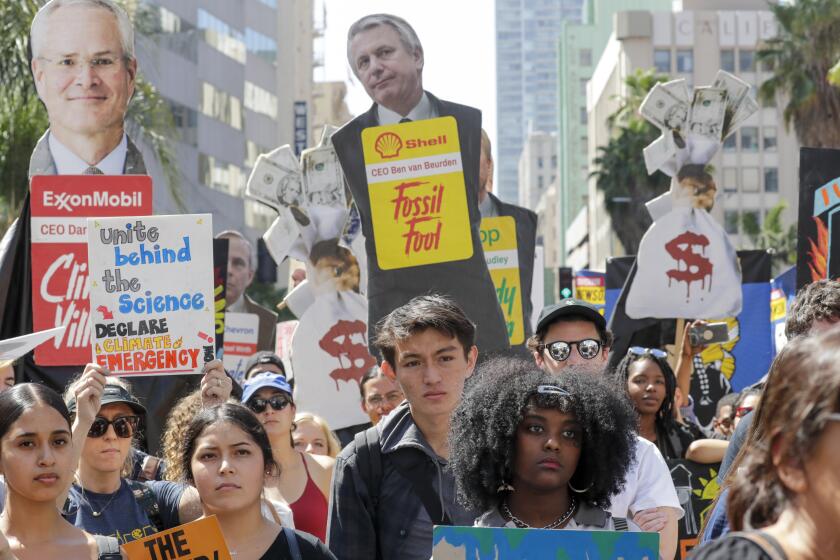The Supreme Court just made it harder to save the planet

- Share via
At a moment when the world should be racing to prevent the worst effects of global warming, the Supreme Court just made it harder for the U.S. to cut carbon emissions from power plants quickly and cost-effectively.
In yet another ruling this session that upended norms, the court said in its 6-3 decision Thursday that the U.S. Environmental Protection Agency overstepped its authority in trying to develop sweeping regulations to reduce climate-warming pollutants.
To be clear, the ruling didn’t remove the EPA’s authority to cut carbon emissions from individual power plants, which are responsible for about a quarter of the nation’s greenhouse gas emissions. The agency still can — and should — require that power plants install equipment that can ratchet down pollution. But the decision limits the EPA’s ability to enact more far-reaching and creative regulatory programs affecting the power sector, such as a nationwide carbon cap-and-trade system similar to California’s that some power industry and business groups have supported as more flexible compliance models.
A landmark U.N. climate report this week broke new ground by finally highlighting the role of misinformation in obstructing action, singling out the United States as hotspot.
With the stakes so high, it’s devastating that the EPA will lose valuable regulatory tools to help slow climate change. The ruling also foreshadows more fights and lawsuits from industry groups attempting to prevent federal agencies from enacting big, important regulations to address evolving problems. The U.S. has a long history of empowering agencies to develop regulations for cleaner air and water, safer workplaces and consumer protections from dangerous products, and the ruling could encourage more challenges to regulatory agencies’ authority.
The majority opinion, written by Chief Justice John G. Roberts Jr., said Congress didn’t give the EPA the power to develop regulations that could shift the power sector from fossil fuels to renewable energy. Such major decisions and transformational programs should come with clear direction from Congress, he argued.
But in a dissent signed by the court’s three liberal judges, Justice Elena Kagan wrote that the majority was ignoring Congress’ intent when lawmakers passed the Clean Air Act in the 1970s — which was to empower the experts to come up with regulatory systems that can evolve over time to reduce emissions in the most cost-efficient, protective way possible. Instead, she argued, the court blocked regulators from carrying out their mandate.
California’s plan to reach net-zero emissions by 2045 shows little ambition for accelerating climate action and must be strengthened to cut more pollution faster.
“Whatever else this Court may know about, it does not have a clue about how to address climate change,” Kagan wrote. “And let’s say the obvious: The stakes here are high. Yet the Court today prevents congressionally authorized agency action to curb power plants’ carbon dioxide emissions. The Court appoints itself — instead of Congress or the expert agency — the decisionmaker on climate policy. I cannot think of many things more frightening.”
She’s right. The stakes are terrifyingly high.
The burning of fossil fuels and other human activity have already warmed Earth by about 2 degrees Fahrenheit compared with preindustrial levels, a United Nations report warned earlier this year. Climate change has worsened wildfires, droughts, air pollution and heat waves; caused species to go extinct and trees to die en masse; swallowed up coastal habitat; reduced crop yields; increased hunger and shrunk glaciers and other crucial water supplies.
The world can still avert the worst consequences of the overheating of our planet — mass extinction and catastrophically severe droughts, floods, heat waves and sea level rise — if emissions are cut in half by 2030. But the United States, the world’s biggest polluter historically, has moved far too slowly to end the nation’s reliance on fossil fuels and transition to clean, renewable energy.
The Supreme Court ruling only makes the work harder. The Biden administration is currently developing a rule to cut carbon from power plants. Thursday’s court decision puts new constraints on possible regulatory models, even ones that might be faster or cheaper than ordering power plants to install pollution-control technology. Still, Biden’s EPA should pursue the most aggressive standards; there’s simply no more time to waste.
The decision also puts the onus on Congress. Sure, Congress could pass a law clearly giving the EPA the authority to pass sweeping regulations to cut carbon. But for decades, Republican and some Democratic lawmakers have refused to act on climate change, punting the responsibility to the executive branch and the EPA. It’s time for Congress to finally buck fossil fuel interests and pass a comprehensive bill to accelerate the shift from coal and gas to clean electricity and clean vehicles.
And Congress should make it abundantly clear that the EPA is empowered to adopt the regulations needed to slash greenhouse gases across industries and slow global warming.
More to Read
A cure for the common opinion
Get thought-provoking perspectives with our weekly newsletter.
You may occasionally receive promotional content from the Los Angeles Times.











